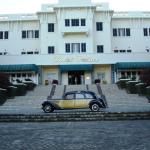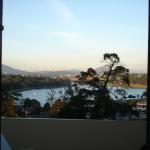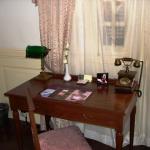Palace Redux
About half way up the carpeted grand staircase of the Dalat Palace, we felt a sense of accordion time. Chronology went askew; time wrinkled, creasing back on itself. Now and then became pleated, and for a moment the two coexisted.
Like an art gallery, the walls along the hallway exhibited paintings by Cézanne, Degas, Monet, and Matisse. Within room 117, the past continued to unfurl, now intent on nudging out the present, supplanting it with the colonial era of the hotel's origin.
The room was spacious, suitable for members of the elite en vacances. Additional Impressionist paintings were displayed on the walls. Highly polished wooden floors creaked under foot. Elaborate chandeliers were hanging from ceilings that must have been five metres tall. A fireplace was in the corner and on the mantle was a bust as well as antique porcelain vases. On one of the desks was a functioning old-fashioned brass and wood telephone, its handset on a pedestal. There was a sitting area with plush chairs arranged around a heavy mahogany table. A queen-size bed was decorated with a silk crown canopy. Overhead, a ceiling fan whirred slowly. On the far wall was an immense mahogany armoire. Entered through folding doors, the bathroom had a deep, claw-footed tub with brass fixtures and hand-held shower. There was another ornate chandelier and more paintings, including Monet's "Boating."
All the décor successfully collaborated to create an aura of the 1920s.
Double French doors provided access to a room-sized balcony with a panorama of Xuan Huong Lake and pine-covered mountains in the background. Both the windows and the door had louvered green shutters.
It's all a chimera. The paintings of course are reproductions; the period pieces are all faux. Here reality as well as time is bent. It is not a deception, but rather a comfortable illusion, a portrayal of colonial Indochina as a romantic sojourn, an extended belle époque. The Dalat Palace is a theatre where guests who have suspended their disbelief, become characters in a colonial drama that is more fiction than historic.
* * *
French colonization came wrapped in a noble rationale-that they were bringing a higher civilization. They believed it was their obligation to Westernize Indochina; in accordance with their theory of cultural assimilation, the allegedly underdeveloped indigenous people would gradually become enlightened once they perceived the superiority of the new way.
In reality, profit-driven colons exploited the country's resources and subjugated the people. Under French domination, the Vietnamese suffered deprivations and humiliations; stripped of their dignity and their civil rights, they were often used as forced labour. How the magical transfer of a greater culture would occur within the colonial policies of social, legal, political, and economic discrimination against a people they considered inferior, remains unclear.
Once Vietnam began to woo tourists in the 1990s, an alternate idealized version of colonialism was manufactured by savvy promoters who sold nostalgia to the French, just as war tourism was being sold to Americans. Indochina was repackaged; the ruthless tyranny was edited out, and instead the focus was on an era of sumptuous lifestyles, of indulgent living in elegant surroundings.
* * *
Even imperialists needed a vacation, a respite from the debilitating heat and the stresses of exploiting a foreign land. Dalat, in the much cooler highlands 320 kilometres northeast of Saigon, provided seasonal escapes, refuges for the privileged. From its beginnings as a sanatorium where colonists could recover from tropical diseases that were both psychological and physiological in nature, Dalat quickly became much more than a place of convalescence. It became a peaceful sanctuary for the colonial elite, a hill station segregated from the local people who resented their presence and who the colonists deemed inferior.
In 1916, in order to attract the colonial high society of Cochinchina, plans were made to construct a palatial hotel resembling those along the Côte d'Azur. Completed in 1922, and built on a hill overlooking the lake, The Lang Bian Palace was a conspicuous symbol of power and prominence, a luxurious venue for the status obsessed to indulge in lavish soirées. It was a resort for the privileged, a social enclave where colons of high society could live the refined life among those of equal status.
Colonial administrators began to envisage Dalat as the future capital of French Indochina. One of the leading architects and urban planners of the time, Ernest Hébrard, was commissioned to create a grandiose design for the city. With the palatial hotel in the centre, the surrounding area would be transformed into France in microcosm from which the colony would be governed.
Perhaps it was the rarified mountain air or just delusional thinking, but the urge to create an edifice that would be a focus for prestige and power seems to have trumped economic viability. From the outset The Lang Bian Palace created fiscal turmoil. When construction began, there was no railway to deliver building supplies. Although the colons had unlimited forced labour, progress was slow, delays were frequent, and the coffers of the colonial administration were being drained. Hébrard's elaborate plans for Dalat were soon abandoned
For a brief time, the privileged savoured the superior standards and lavish comfort of a hotel on the level of those in Paris; in addition to socializing, hunting became the main diversion for these affluent guests-in the 1920s the foothills of the Lang Bian Mountains abounded with wild boars, deer, tigers, bears, rhinoceroses, and elephants. But the Lang Bian's period of grandeur was ephemeral.
* * *
From the back seat of the vintage black and gold Citroen used by the Dalat Palace to chauffeur guests on short tours of the city, we watched our driver, Mr. Dien, shift through the gears. We chugged along Tran Hung Dao Street past villas built by the colonial elite from the 1920s to the 1940s. Frequently he would reach over to the centre of the dashboard to push the horn button-Vietnamese consider horn honking an integral part of driving. Mr. Dien drove slowly so we could appreciate the buildings; at one point, he stopped in front a villa with a distinct Art Deco styling. "I would like to introduce to you Monsieur Veysseyre," he said, presenting the villa built by the French architect as if it were the man himself. Veysseyre was responsible for the construction of several hundred of these chateaux during World War II. Once there were over two thousand, their architectural styles reflecting the home regions of the owners. Although many of the homes had been restored, numerous were also in a severe state of neglect. When we asked about these mouldering mansions, Mr. Dien explained that they were owned by the government and that these derelict structures would soon be renovated. Something in the tone and expression of the word soon suggested that restoration plans had been long delayed.
Later we were to learn that these villas of Dalat, among additional factors, had played a role in the decline of the Lang Bian Palace. We also discovered that before an entrepreneurial intervention in 1991, the grand hotel had been in a similar condition of decrepitude as many of these homes.
* * *
Although it only contained thirty rooms, occupancy at the Lang Bian Palace became a problem from the outset. The wealthy clients wooed by the Palace were building their own villas.
By the end of the 1920s, Indochina suffered back-to-back economic disasters: a plunge in the price of rubber was followed by the worldwide depression. The grand palace remained in its aloof position overlooking the lake, majestic and empty.
Toward the end of World War II, it was occupied by the Japanese, as was the case with most opulent hotels across Southeast Asia. When the war ended, the French reoccupied Indochina, but this time they faced active opposition; the Franco-Vietnamese War lasted eight years; its conclusion saw the French defeated and the end of their Empire in Indochina. Ownership of the Palace was now in the hands of the South Vietnamese Government and the hotel was renamed the Dalat Palace Hotel. A change in name did not improve the hotel's lot, and it continued to languish.
With the exception of ten days of fighting during the Tet Offensive, Dalat was unaffected by what they call the American War here. Throughout the conflict, although the hotel was officially open, it remained virtually deserted.
Following the war, the hotel was expropriated by the Communists, but it was left abandoned, a derelict vestige of a long-gone era. Like many of those villas along Tran Hung Dao Street, it was left abandoned and decaying.
* * *
Located in the basement of the Dalat Palace, Larry's Bar is a grotto-style hideaway and the former wine cellar of the original hotel. There are beamed ceilings, stone walls, several small rooms with plush couches and chairs, fireplaces, and a billiard table; a locked glass cabinet holds dozens of liquor bottles in various degrees of fullness, each with a tag labelled with the owner's name. Prominently displayed beside the bar, there is a large photograph of, as we were informed by the bartender, Larry Hillblom.
"He is responsible for restoring the hotel," she explained, somewhat surprised that we did not know of him. She turned over the drink menu which contained a short, and we were to later to discover, bowdlerised biography.
Captivated by Dalat during a 1990 visit, the American millionaire saw the tourist potential of recreating the colonial era-the edited romantic version. Not only was he responsible for saving the derelict Lang Bian Palace, but his multi-million dollar investment financed the restoration of the nearby H?tel du Parc as well as a number of dilapidated villas; in addition he expanded the small golf course into a world-class venue.
"He had many children, but no wife," the bartender interjected with a wry smile, but added no more details. She may have assumed that we were aware of the soap opera that ensued following his death in an airplane crash, the same month that the restored hotel opened.
Regardless of the titillating details that surfaced after his death, it was because of Hillblom that the former Lang Bian Palace was reborn in 1995 in an even grander, more opulent image of her former self. Unlike her original incarnation, the grand hotel's renaissance was felicitous.
* * *
Le Rabelais, the hotel's signature restaurant gastronomique, is the keystone of the reborn grand hotel. It has a growing reputation with gourmands worldwide for its exceptional French cuisine, knowledgeable and attentive service, and elegant ambience.
On our first night, our waiter made suggestions and answered our menu questions. He was personable and informative, without a trace of aloofness. We learned that he was Swedish and serving an Accor-sponsored internship.
When scanning the extensive wine list, we noticed that the infamous Dalat Red was not present and asked why. We had seen bottles on shelves in the market but had yet to taste it. Although we had been often warned not to bother, we wanted to at least give it a sample.
He paused as if pondering how to answer and then grinned as he spoke, "We do not serve it in Le Rabelais. It does not complement the cuisine." He appeared to have more to say, but seemed reluctant to continue. When we asked if he had tried it, he mimicked a shudder before saying, "Unfortunately, yes." His smile broadened at our amusement with his reply. "I think it is made from a mixture of grapes and fruit, but I'm not sure. The white isn't too bad if it is really chilled. If you want to sample the taste of Dalat, I would suggest you stick with the vegetables." Dalat's climate and fertile soil provide ideal conditions for the growing of vegetables and flowers; indeed, seventy percent of the produce in the country is from Dalat. Earlier in the day, we had seen artichokes the size of melons at the market and at lunch had sampled Dalat's famous artichoke tea known for its curative properties.
Our meals at Le Rabelais were always culinary indulgences; we were in gastronomic bliss whether we ordered the eight-course dégustation menu, the six-course Palace traditional prix fixe dinner, or from the ample choices offered à la carte.
When the bread selection was presented, we always chose the warm, flavourful, and addictive artichoke buns. Memorable starters included a savoury foie gras and artichoke compote; a favourite from the soup course was a tasty green asparagus bisque with grilled foie gras.
Among the delectable mains were wild boar stewed in red wine; Angus beef en Rossini-with truffles and seared melt-in-your-mouth foie gras; fresh steamed and vanilla-infused lobster from Nha Trang; and duck in three variations-succulent breast filet, buttery foie gras, and tangy confit served with fresh orange.
Once the mains were presented, the stainless steel covers lifted simultaneously and with a flourish, a server brought a selection of steamed and grilled local vegetables-carrots, parsnips, turnips, sweet peppers, zucchinis, cauliflowers. He named each vegetable as he presented each portion like a gift.
On our last night in Dalat, more out of curiosity than necessity, we decided on sharing a tray of imported French cheeses. Our friendly Swedish waiter described each of the many choices and after we had made our selections, insisted that we really should sample a few others. He checked our wine, an Australian cabernet sauvignon, and found it empty. "This is not acceptable for the cheese course," he announced and soon returned with two half-full glasses. "Don't worry, it's not Dalat Red," he laughed.
Dessert would have been superfluous this evening, and we chose instead to appreciate the post-dinner lassitude, aiding digestion with Pernod. Once again, our gastronomic indulgences had outlasted the candle that now flickered its final flames.
Materializing at our table like a phantom in white, stood Executive Chef Linh, hands behind his back and a smile on his face. Accepting our compliments with a slight bow, he wished us good travels and the hope that we would return to Dalat soon. After hand shakes and assurances that his cuisine would certainly draw us back, the spectre vanished as swiftly as he had appeared.
* * *
On the morning of our departure, we lingered over an early breakfast on the veranda. In dawn's emerging light, the mists were rising off Xuan Huong Lake; named after a poet, at this hour the lake was an enchanted dream world, itself a poem. Made wistful by the scene and our reluctance to leave Dalat, we mused on our time here. We had been willing actors in a quixotic colonial play. Already we were anticipating a repeat performance on this magnificent stage-Dalat's grande dame on the hill.
* * *
Fact File:
Sofitel Dalat Palace
12 Tran Phu Street
Dalat City, Vietnam
Phone: (+84) 63-3825444
Fax: (+84) 63-3825457
The Sofitel Dalat Palace has forty-three rooms, including five suites. In addition to Le Rabelais, the Dalat Palace also has two other restaurants on the property. Both are located in what is known as the Triangle Building, built in 1928 as a luxury boutique. On the ground floor is the Café de la Poste which resembles a French bistro. Upstairs is Y Nhu Y, which specializes in Vietnamese cuisine.
* * * * *
 ThingsAsian
ThingsAsian



















